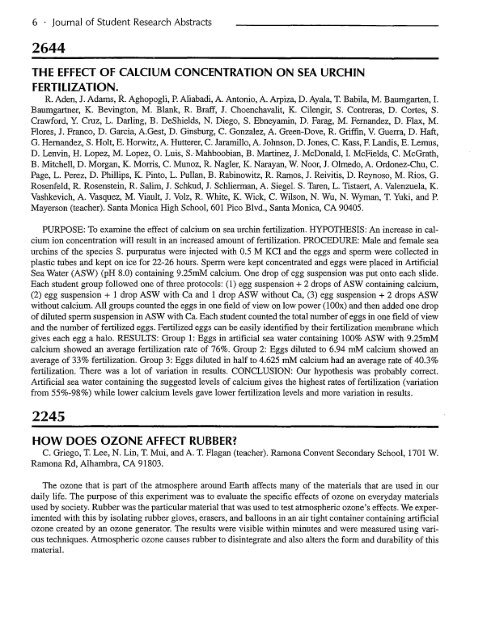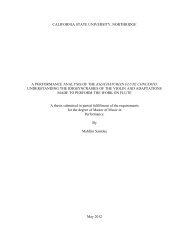2644 - CSUN ScholarWorks - California State University, Northridge
2644 - CSUN ScholarWorks - California State University, Northridge
2644 - CSUN ScholarWorks - California State University, Northridge
Create successful ePaper yourself
Turn your PDF publications into a flip-book with our unique Google optimized e-Paper software.
6 · journal of Student Research Abstracts<br />
<strong>2644</strong><br />
THE EFFECT OF CALCIUM CONCENTRATION ON SEA URCHIN<br />
FERTILIZATION.<br />
R. Aden, J. Adams, R. Aghopogli, P. Aliabadi, A. Antonio, A. Arpiza, D. Ayala, T. Babila, M. Baumgarten, I.<br />
Baumgartner, K. Bevington, M. Blank, R. Braff, J. Choenchavalit, K. Cilengir, S. Contreras, D. Cortes, S.<br />
Crawford, Y. Cruz, L. Darling, B. DeShields, N. Diego, S. Ebneyamin, D. Farag, M. Fernandez, D. Flax, M.<br />
Flores, J. Franco, D. Garcia, A.Gest, D. Ginsburg, C. Gonzalez, A. Green-Dove, R. Griffin, V. Guerra, D. Haft,<br />
G. Hernandez, S. Holt, E. Horwitz, A. Hutterer, C. Jaramillo, A. Johnson, D. Jones, C. Kass, F. Landis, E. Lemus,<br />
D. Lenvin, H. Lopez, M. Lopez, 0. Luis, S.· Mahboobian, B. Martinez, J. McDonald, I. McFields, C. McGrath,<br />
B. Mitchell, D. Morgan, K. Morris, C. Munoz, R. Nagler, K. Narayan, W. Noor, J. Olmedo, A. Ordonez-Chu, C.<br />
Page, L. Perez, D. Phillips, K. Pinto, L. Pullan, B. Rabinowitz, R. Ramos, J. Reivitis, D. Reynoso, M. Rios, G.<br />
Rosenfeld, R. Rosenstein, R. Salim, J. Schkud, J. Schlierman, A. Siegel. S. Taren, L. Tistaert, A. Valenzuela, K.<br />
Vashkevich, A. Vasquez, M. Viault, J. Volz, R. White, K. Wick, C. Wilson, N. Wu, N. Wyman, T. Yuki, and P.<br />
Mayerson (teacher). Santa Monica High School, 601 Pico Blvd., Santa Monica, CA 90405.<br />
PURPOSE: To examine the effect of calcium on sea urchin fertilization. HYPOTHESIS: An increase in calcium<br />
ion concentration will result in an increased amount of fertilization. PROCEDURE: Male and female sea<br />
urchins of the species S. purpuratus were injected with 0.5 M KCI and the eggs and sperm were collected in<br />
plastic tubes and kept on ice for 22-26 hours. Sperm were kept concentrated and eggs were placed in Artificial<br />
Sea Water (ASW) (pH 8.0) containing 9.25mM calcium. One drop of egg suspension was put onto each slide.<br />
Each student group followed one of three protocols: (1) egg suspension+ 2 drops of ASW containing calcium,<br />
(2) egg suspension + 1 drop ASW with Ca and 1 drop ASW without Ca, (3) egg suspension + 2 drops ASW<br />
without calcium. All groups counted the eggs in one field of view on low power (1 OOx) and then added one drop<br />
of diluted sperm suspension in ASW with Ca. Each student counted the total number of eggs in one field of view<br />
and the number of fertilized eggs. Fertilized eggs can be easily identified by their fertilization membrane which<br />
gives each egg a halo. RESULTS: Group 1: Eggs in artificial sea water containing 100% ASW with 9.25mM<br />
calcium showed an average fertilization rate of 76%. Group 2: Eggs diluted to 6.94 mM calcium showed an<br />
average of 33% fertilization. Group 3: Eggs diluted in half to 4.625 mM calcium had an average rate of 40.3%<br />
fertilization. There was a lot of variation in results. CONCLUSION: Our hypothesis was probably correct.<br />
Artificial sea water containing the suggested levels of calcium gives the highest rates of fertilization (variation<br />
from 55%-98%) while lower calcium levels gave lower fertilization levels and more variation in results.<br />
2245<br />
HOW DOES OZONE AFFECT RUBBER?<br />
C. Griego, T. Lee, N. Lin, T. Mui, and A. T. Flagan (teacher). Ramona Convent Secondary School, 1701 W.<br />
Ramona Rd, Alhambra, CA 91803.<br />
The ozone that is part of the atmosphere around Earth affects many of the materials that are used in our<br />
daily life. The purpose of this experiment was to evaluate the specific effects of ozone on everyday materials<br />
used by society. Rubber was the particular material that was used to test atmospheric ozone's effects. We experimented<br />
with this by isolating rubber gloves, erasers, and balloons in an air tight container containing artificial<br />
ozone created by an ozone generator. The results were visible within minutes and were measured using various<br />
techniques. Atmospheric ozone causes rubber to disintegrate and also alters the form and durability of this<br />
material.













